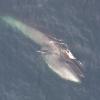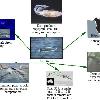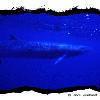

Tags: Sei Whale View |
Sei Whale Tags: Sei Whale View |
Sei whale Tags: Sei Whale View |
|||||||||
B. borealis binomial = Balaenoptera borealis binomial_authority = Lesson (Ren� Primev�re Lesson), 1828 range_map = Cetacea range map Sei Whale.PNG range_map_caption = Sei Whale range,
The Sei Whale (pron-en?se? or IPA-en?sa?), Balaenoptera borealis, is a baleen whale, the third-largest rorqual after the Blue Whale and the Fin Whale. It inhabits most oceans and adjoining seas, and prefers deep off-shore waters. It avoids polar (Polar region) and tropical (tropics) waters and semi-enclosed bodies of water. The Sei Whale migrates annually from cool and subpolar waters in summer to winter in temperate (temperateness) and subtropical (subtropics) waters.
Reaching m to ft20 long and weighing as much as convert45t, the Sei Whale daily consumes an average of kg to lb900 of food, primarily copepods, krill, and other zooplankton. It is among the fastest of all cetaceans, and can reach speeds of up to convert50km/hmph, 27 knots (Knot (unit))) over short distances. The whales name comes from the Norwegian (Norwegian language) word for pollock, a fish that appears off the coast of Norway at the same time of the year as the Sei Whale.
Following large-scale commercial whaling (whaling) during the late-nineteenth and late-twentieth centuries when over 238,000 whales were taken, the Sei Whale is now internationally protected, although limited hunting occurs under controversial research programmes conducted by Iceland and Japan. As of 2006, its worldwide population was about 54,000, about a fifth of its pre-whaling population.
Image2: Sei_whale_size.svg
Image2 Caption: Size compared to an average human
Status System: iucn3.1
Regnum: Animalia
Phylum: Chordata (Chordate)
Classis: Mammalia
Ordo: Cetacea
Subordo: Mysticeti (baleen whale)
Familia: Balaenopteridae (rorqual)
Genus: ''Balaenoptera''



